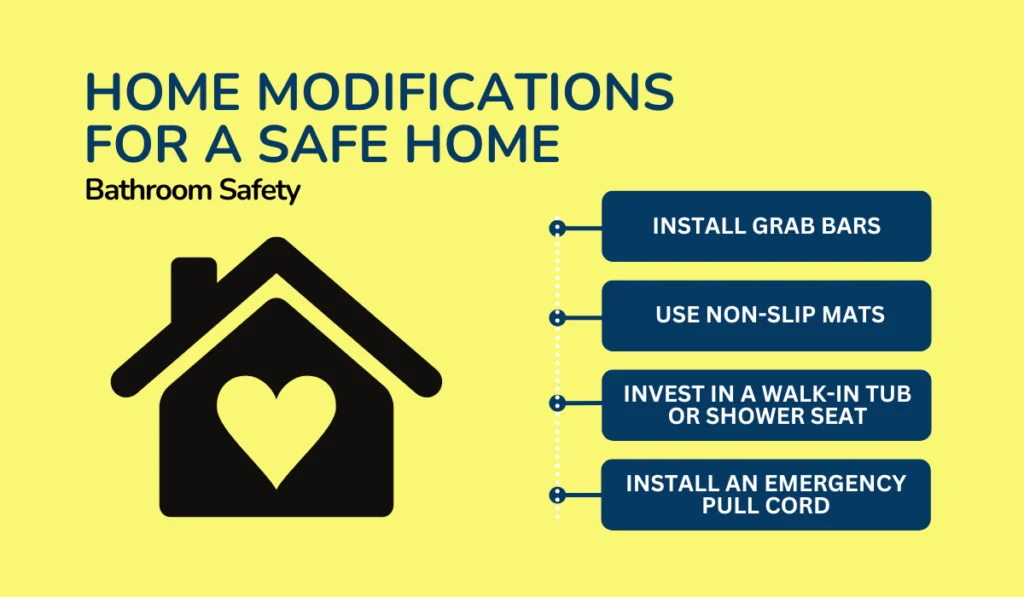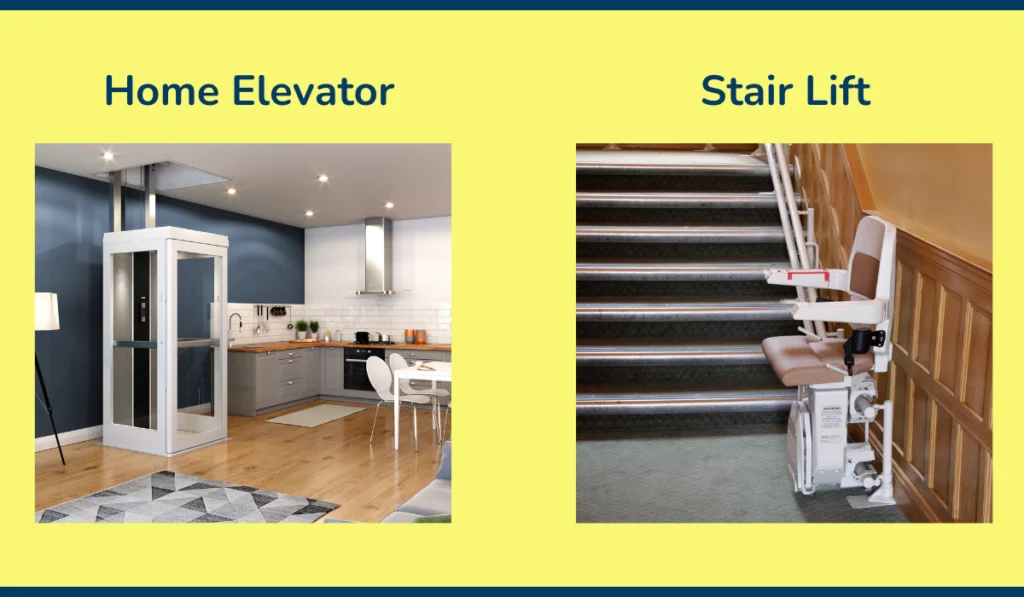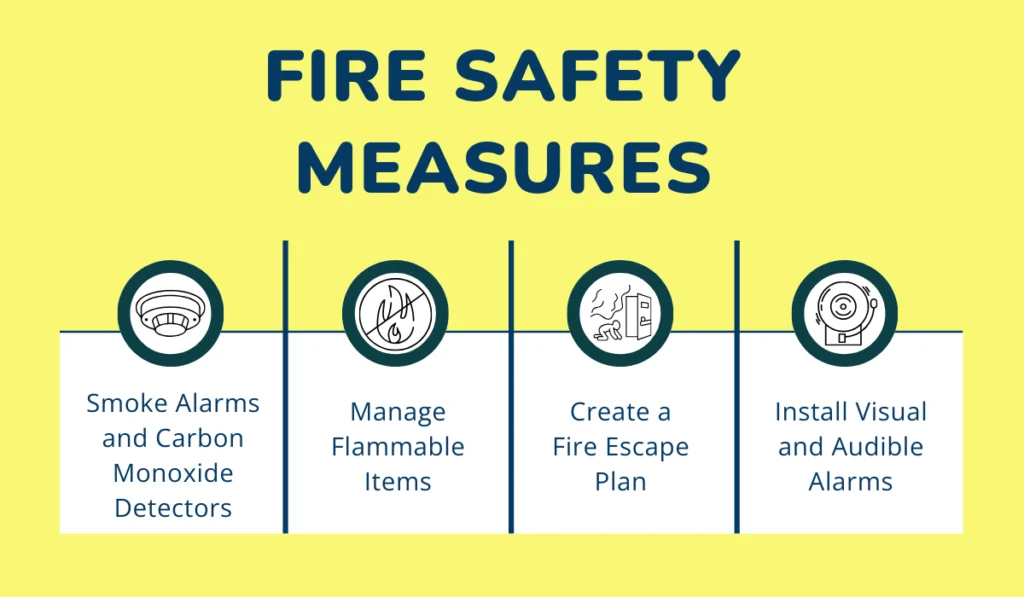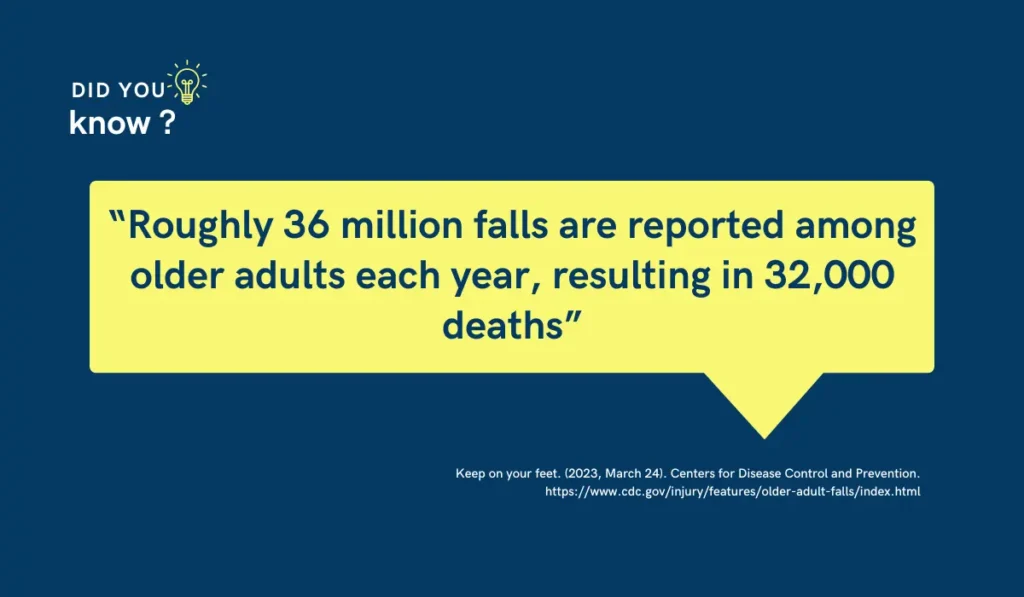Whether you’re a care provider or looking out for an older family member, making their home safer is crucial.
In this guide, we’ll discuss some potential hazards in the home and provide tips on how to prevent them.
Key Takeaways
- Improve lighting in stairs, halls, and bathrooms to make it safer and easier for older people to move around.
- Check medications with doctors to handle side effects that might affect movement or thinking.
- Use simple security systems, like touch screens and voice commands, to keep homes safe for seniors.
- Seniors can get help from groups like HUD and Medicaid HCBS to make their homes safer.
Home Modifications for a Safe Home
Entryway Adjustments

Accessible entryways are crucial for older adults struggling with mobility and balance. Here are two essential modifications to consider:
Add Ramps and Handrails
- Install ramps and handrails for those who use wheelchairs or walkers.
Enhance Lighting and Install Non-Slip Flooring
- Replace old light bulbs to maintain bright, even lighting that enhances visibility.
- Install non-slip flooring to prevent accidents common in dimly lit areas.
Bathroom Safety

Ensuring the safety of older adults in the bathroom is critical due to the high risk of slips and falls in this area. You’ll want to focus on adding the following items for bathroom safety:
Grab Bars and Non Slip Mats
- Install grab bars around the toilet and within the shower area.
- Non-slip mats should be placed inside the shower and bath mats beside the bathtub for better grip.
Walk-in Tubs and Shower Seats
- Invest in walk-in tubs to eliminate the need to create easy access.
- Install shower seats to provide a stable place for seniors to sit while bathing, and reduce the risk of slipping.
Emergency Pull Cords
- Install emergency pull cords within easy reach of the toilet, shower, and bathtub so seniors can quickly alert caregivers or emergency services in case of a fall or medical emergency.
Install Raised Toilet Seats: These are great for accessibility and easier bathroom use.
Consider Setting the Water Heater to 120 Degrees or Less: This will help prevent accidental scalding while showering.
Bedroom Modifications
It’s important for seniors to get in and out of bed safely. So, start by checking the bed height. A bed that’s too high or low can cause falls or injuries.
The best height is when feet can touch the floor and knees are even with hips while sitting on the edge. Think about using bed risers to get the height right. Ensure the bed is also stable and strong for a safe rest.
Additionally, night lights should be put along paths to help seniors see in the dark.
A light switch close to the bed or a remote-controlled lamp can also help older people move around and turn lights on and off more easily.
Bedroom Checklist:
- Double-check bed height
- Ensure the bed is stable
- Install night lights
Kitchen Adaptations
To make kitchens safer for older adults, focus on simple, effective changes that address their unique needs and reduce common risks. For example:
Lower Shelves and Accessible Storage
- Keep commonly used items at waist level to minimize reaching or bending, reducing the risk of falls.
- Equip cabinets with pull-out shelves and lazy Susans for easier access to kitchenware, which helps reduce strain.
Safe Appliances
- Install appliances with automatic shut-off to prevent fires and burns, such as electric stovetops and kettles that turn off automatically.
- Include microwaves with auto shut-off for safer meal prep and keep a fire extinguisher accessible for emergencies.
Stair Safety
Stairlifts and Home Elevators

Consider installing stairlifts for seniors who struggle with stairs. These devices provide a safe and comfortable way to navigate between floors, minimizing the physical strain and risk of falls.
For homes with enough space and budget, installing home elevators offers an even safer and more convenient solution, allowing seniors to bypass stairways altogether.
Enhanced Lighting and Sturdy Railings
Install bright, even lighting on stairs to make each step visible and prevent accidents.
Also, add motion-sensor lights that turn on as someone approaches, which are especially helpful in usually dim areas.
Also, you should install sturdy railings on both sides of staircases to support seniors, helping them maintain balance for safer ascents and descents.
Ensure these railings are securely mounted at the correct height for maximum safety. Consider adding treads as well. These add texture to stairs, enhancing grip for safer walking.
Fire Safety Measures

To guarantee safety and fire-proof a home, consider implementing these crucial measures:
- Smoke Alarms and Carbon Monoxide Detectors: Install and maintain these devices throughout your home. They are critical for early warning in emergencies, providing crucial time to react.
- Manage Flammable Items: Keep all flammable materials away from heating equipment and ensure heating systems are inspected and maintained regularly. This is vital to reduce fire risks, particularly during the colder months.
- Fire Escape Plan: Create a comprehensive escape plan with multiple exits from every room and a designated meeting spot outside. Practice this plan regularly with all household members, including children, to ensure everyone knows what to do in case of a fire.
- Visual and Audible Alarms: Install visual alarms along with audible ones for those with hearing impairments. These alarms, which use bright flashing lights, help alert everyone quickly to danger.
Emergency Communication Systems
Personal Emergency Response Systems (PERS)
Give seniors living alone Personal Emergency Response Systems (PERS). These medical alert devices are like pendants or wristbands and let users call for help with a button press.
This quick link to emergency services or caregivers is essential for those with mobility issues, chronic conditions, or who live alone, offering peace of mind.
Emergency Smart Home Devices
Smart home tech is excellent for senior safety and keeping their home safe. Here are a few options to consider:
Voice-Controlled Devices: Use smart speakers and home hubs for easy, hands-free calling and messaging.
Motion Sensors: Set up sensors to detect unusual movements, quickly alerting caregivers or emergency services if needed.
Door Security: Install smart doorbells and cameras at the front door to let residents see and talk to visitors without opening the door. As a side note, adding grip-enhanced doorknobs can also make doors easier to open.
List of Emergency Contacts
Keep an emergency contact list handy. Include numbers for local emergency services, family, friends, and health or home care service providers.
Place it in easy-to-see places like on the refrigerator, near the phone, or in emergency kits.
Also, keep this list on mobile devices and link it to smart home systems to ensure help is just a call away.
If needed, get your senior a basic cell phone. Cell phones are a simple yet effective way for seniors to stay connected in their homes.
Basic Fall Prevention

As mentioned, fall risks are a major hazard for older adults at home. But you can take several general steps to reduce this issue:
Declutter for Safety
- Regularly remove clutter and other trip hazards from walkways and common areas.
- Tape down extension electrical cords.
Secure Rugs and Carpets
- Use non-slip pads or double-sided tape to keep rugs (e.g., throw rugs, area rugs, etc.) and carpets firmly on the floor.
- Choose low-pile carpets to help prevent trips and falls.
Enhance Home Lighting
- Install bright LED lights and nightlights in key areas such as stairwells, hallways, living rooms, and bathrooms.
Medication Review
- Regularly review all medications with healthcare providers to identify any side effects that might impair balance.
Home Security
Home security is vital for seniors, offering protection and peace of mind. Here are some ways to make their environments safer:
User-Friendly Home Security Systems: Modern security systems feature big buttons, voice commands, and touch screens tailored for senior accessibility.
These systems are simple to use and can promptly alert family or emergency services. They incorporate technologies like facial recognition and easy-to-use apps, enhancing senior safety without overwhelming them.
Door and Window Security Enhancements: Securing doors and windows is crucial to ensure home safety.
Install deadbolt locks, window bars, or motion sensors to alert if tampering occurs. Smart locks and electronic door viewers further enhance security, enabling remote access and the ability to view visitors without needing to open the door.
Neighborhood Watch Programs: Neighborhood watch programs improve safety for seniors through group watchfulness and support.
Activities include monthly meetings, coordinating neighborhood patrols, sharing safety tips, collaborating with local law enforcement, and participating in police-led safety workshops. The result is a safer environment for seniors to call home.
Resources and Assistance
Financial Aid Resources for Home Modifications
Seniors looking for help to make their homes safer and easier to use have many options available:
HUD Programs: The U.S. Housing and Urban Development helps pay for home changes with programs like the Older Adult Homes Modification Program and the 203(k) Rehab Mortgage Insurance Program.
Veterans Affairs Grants: The U.S. Department of Veterans Affairs provides grants for veterans with service-related disabilities who need home modifications.
Medicaid HCBS Waivers: These waivers help cover the cost of home renovations to support seniors in living independently. Information varies by state, so it’s recommended you contact your local Medicaid office.
Rebuilding Together: This non-profit organization helps seniors by modifying homes to enhance safety and accessibility.
Seniors and their caregivers are encouraged to contact these organizations directly or visit their websites for more information on eligibility and application processes.
Home Safety Workshops and Classes
Local councils, community centers, and hospitals often host workshops and classes to educate seniors on home safety tips.
These sessions may cover various topics, including fall prevention, essential home repairs, general home care, and how to use new security technologies.
Some examples include:
- Local Senior Centers: Frequently offer seminars and workshops on many topics tailored to the needs of older adults.
- Community Colleges: May provide non-credit courses or workshops in home safety and DIY home modifications.
- Local Fire Departments and Police Stations: Often host community safety workshops, including advice on preventing home invasions and what to do in an emergency.